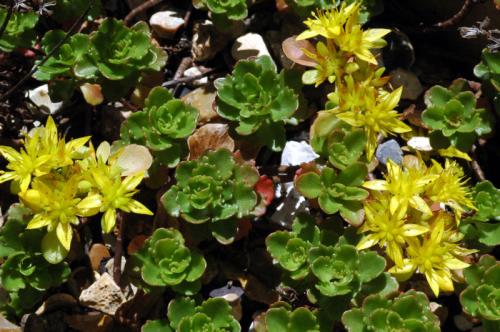HYBRIDUS (L.) 't Hart, 1995
Synonyms :
Sedum hybridum var. dentatum hort. (s.a.) / Sedum hybridum L. (1753) / Anacampseros hybrida (L.) Haworth (1819) / Aizopsis hybrida (L.) Grulich
(1984)Sedum hohenackeri Gandoger (1886)
Sedum vagans Gandoger (1886)
Sedum sibericum E.H.L.Krause (1902)
Sedum sibiricum E.H.L.Krause (1902)
Subgenus Aizoon.
Distribution : Russia (eastern and central Siberia to the southern and central UraI Mts.), central Asia; stony and gravelly soils, rock crevices, predominantly in mountain steppes, less often in the southern part of the forest zone; naturalized in northern Europe.
Description (according to IHSP, 2003) :
Tufted herbs with a thick and woody rootstock and short decumbent hibernating sterile stems with crowded leaves at the tip.
Leaves obovate to oblong-cuneate or spatulate, obtuse, reddish-dentate towards tip, petiolate with a petiole as long as the lamina, lamina 10 - 40 (-50) x 8 - 20 mm.
Flowering branches ascending, 10 - 30 cm, with smaller more remote leaves.
Inflorescence terminal lax (dense according to Fröderström (1932) and Borissova (1939)) corymbs.
Flowers : Sepals basally connate, lanceolate, obtuse, mamillate in the upper part, 6 - 8 mm, petals connate for up to 2 mm, acute, short-mucronate, 6 - 10 x ± 1.5 mm, (golden-)yellow, filaments shorter than the petals, yellow, anthers orange.
Probably described from cultivated material. Its status within Subgenus Aizoon is uncertain. Sedum pseudohybridum Voroschilov & Schlothgauer 1984 was described from the Amur-District, and is, to judge from the epithet, similar to this taxon. Its poor description does not allow an interpretation and it is therefore treated as unresolved.
